The Nanticoke region is deeply tied to its historical roots. We are reminded of the history of the area constantly – from the many museums and restored historical buildings that pepper the watershed, to the towns, creeks, and roads that bear the names of many Native American tribes that were once predominant throughout the area. It is impossible to visit the Nanticoke River without feeling connected to the history that surrounds you here. If you want to explore the area’s rich history, here are a few sites to get you started.
Maryland
Caroline County
Please note – only one town in Caroline County lies within the Nanticoke Watershed. However, additional nearby sites have been included here for your convenience.
- Civil War Trail – Caroline County boasts six sites on the Maryland Civil War Trail, including: Greensboro, where pro-Union residents sought help from President Lincoln against alleged Rebel arsonists; Denton Wharf, where arrested Southern sympathizers departed by steamboat for imprisonment at Fort McHenry; Caroline County Courthouse, where Unionists rigged the vote that emancipated Maryland slaves in 1864; and the Nanticoke River near Federalsburg, a “smuggler’s paradise” early in the war.
- [AnythingPopup id=”25″] – Charles H. Dickinson was born on the adjacent farm into a family which achieved national prominence through John Dickinson, “Penman of the Revolution.” A State Historic Marker identifies the site.
- [AnythingPopup id=”26″] – Following the arrival of the Pennsylvania Railroad in 1868, goods from area mills and tanyards were transported from Federalsburg by rail to larger markets in New York and Philadelphia. The Railroad Station dates to c. 1870.
- Federalsburg Heritage Museum – The Federalsburg Area Heritage Museum is housed in the historic Covey and Williams garage building. The restored structure features unique artifacts and exhibits of local heritage.
- Harriett Tubman Underground Railroad Byway – A driving tour highlighting sites that tell the story of the Underground Railroad and “conductor” Harriet Tubman, who led many out of slavery to freedom in the mid-1800s. In Caroline County, some popular stops along the tour include Poplar Neck near Preston where Harriet Tubman made her greatest rescues; the Jacob Leverton Dwelling, (privately owned), the only documented Underground Railroad station building remaining on the Eastern Shore of Maryland; and the Courthouse Square in Denton, the site of numerous incidents and the jail that held captured freedom seekers and Underground Railroad agents.
- Historic Black Schools of Caroline County Driving Tour – Through 90 years of racial segregation and funding disparity, black schools in Caroline County were sacred ground in the fight for equal education, democracy, and civil rights. Nine are still standing. This is a self-guided tour with a map or mobile-friendly app.
- Linchester Flouring Mill Complex – One of the last water-powered mills on the Eastern Shore, it ceased operating in 1979 when the mill pond dam broke after heavy rains. The structure has been described as a “treasure of America” because its original equipment reflects the long evolution of American milling. Of special interest is the Fitz waterwheel on the south (rear) side of the mill, and the Miller’s dwelling across the road.
- The Museum of Rural Life tells the stories of early Americans living in Caroline County’s agriculture-based economy. The museum exhibits includes the Taylor-Brown Dwelling, the Painter’s Range log cabin, and portions of the Chance’s Desire, and Skillington’s Right properties.
- [AnythingPopup id=”28″] – Preston was founded in 1846 around Frazier’s Chapel, an early Methodist Church. First called Snow Hill, the name was changed to Preston by an act of legislature in 1856, in honor of a prominent Baltimore lawyer.
For more information about Historical Sites of Interest, please visit the Caroline County Office of Tourism website.
Dorchester County
- Bucktown General Store – The Bucktown General Store is the historic site where Harriet Tubman braved her first act of public defiance and suffered the head injury that changed her life forever. Certified guides provide an amazing picture of Harriet Tubmans early life in Bucktown. Tours by appointment.
- Dorchester Heritage Museums and Gardens – Featured on the campus is the Meredith House (c.1760) with artifacts and exhibits supporting family life in Dorchester County through time. Genealogy and family history research assistance is available with a research library. The Neild Museum focuses on farming life in the County. An 18th century strong house, a combination wheelwright/blacksmith shop, and formal herbal gardens are on site. The Robbins Heritage Center opened in 2007 and houses the Canning Exhibit, Timbering in Dorchester, Marine Trades, Hunting and Trapping, War of 1812, and Native American Exhibits.
- Handsell National Register Historic Site – The historic plantation house known as Handsell is located north of Vienna, Maryland on Indiantown Road. The Handsell house is built on the site of the Chicone Native American village. It is managed by the Nanticoke Historic Preservation Alliance and now offers Guide by Cell Audio Tours to interpret the Native People’s contact period with the English, the enslaved and later African American story, and the life of all those who lived at Handsell.
- The Harriet Tubman Memorial Garden – Located on Route 50 near the intersection of Washington Street in Cambridge, this site features interpretive signs and a mural to pay tribute to her and those who traveled to freedom from slavery on the Underground Railroad.
- Harriet Tubman Museum and Educational Center – Underground Railroad ‘conductor’ Harriet Tubman was born in Dorchester County. At this small museum in downtown Cambridge, learn about the strength, courage, and determination of this remarkable woman. The museum offers exhibits and a short film about Tubman’s life, as well as a resource area. Groups are welcome; please call ahead. The museum can also organize tours of the area where Tubman lived and toiled.
- Harriet Tubman Underground Railroad Byway – A driving tour highlighting sites that tell the story of the Underground Railroad and “conductor” Harriet Tubman, who was born here and led many out of slavery to freedom in the mid-1800s. Maps, downloadable PDFs, and free mobile apps are available for self-guided tours.
- Old Trinity Church – Old Trinity Church is a tiny gem of 17th century architecture located on a tranquil Chesapeake waterway six miles south of Cambridge.
- Spocott Windmill and Village – ‘Spocott’ today has the only existing post windmill for grinding grain in Maryland. Also on the property are a colonial tenant farmhouse and a one-room schoolhouse.
- Stanley Institute – This 19th century one-room African American schoolhouse was moved to this location in 1867. It is one of the oldest Maryland schools to be organized and maintained by a black community.
- Taylor’s Island – Taylor’s Island is located on Route 16 West in the southern part of the County. Unique homes, schoolhouses, and three churches are points of interest. The Becky Phipps Cannon is displayed on the island, telling of its capture from a British ship off Taylor’s Island during the War of 1812. Many sites on the island are listed on the National Historic Register.
- Vienna Heritage Museum – This museum is dedicated to the rural life and industries located in and near Vienna. It is home to the last operational mother of pearl button factory machinery in the United States and also displays personal family heirlooms.
For more information on planning your visit to Dorchester County, including additional historical sites located throughout the County, please visit the Tour Dorchester County website.
Wicomico County
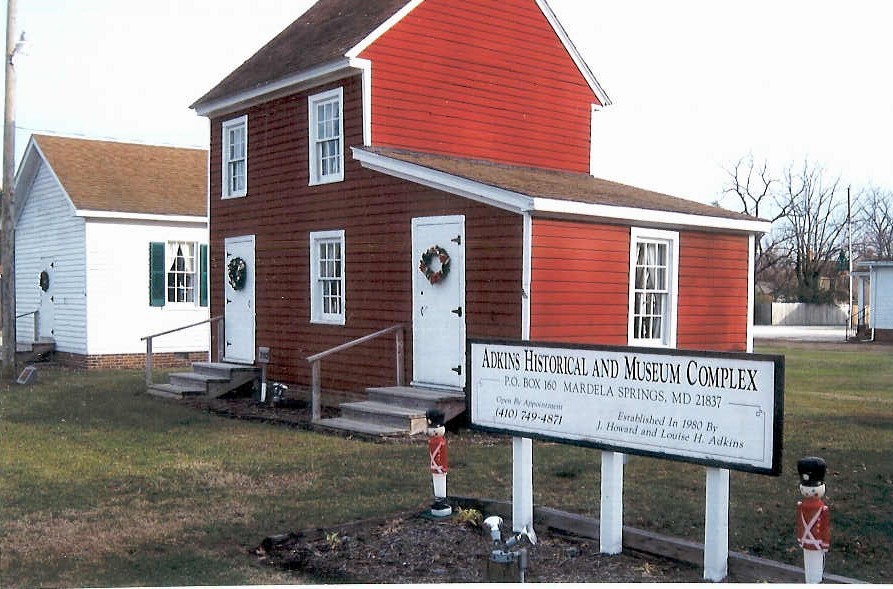 Adkins Historical Complex & Museum – The Adkins Historical and Museum Complex, Inc. was created and developed in 1980 by J. Howard and Louise Adkins in Mardela Springs. Their dedication to “preserving the past” allows us to turn back time more than a century and get a glimpse into life in the village of Barren Creek Springs. Ten historical buildings and a privy are open for free tours by appointment.
Adkins Historical Complex & Museum – The Adkins Historical and Museum Complex, Inc. was created and developed in 1980 by J. Howard and Louise Adkins in Mardela Springs. Their dedication to “preserving the past” allows us to turn back time more than a century and get a glimpse into life in the village of Barren Creek Springs. Ten historical buildings and a privy are open for free tours by appointment.- Barren Creek Heritage Center and Museum – Run by the Westside Historical Society, the Barren Creek Heritage Museum offers tours by appointment only during the week, and is open on Sundays from April through October, from 1-4pm.
- Barren Creek Presbyterian Church – Built in 1862, the Barren Creek Presbyterian Church was the first church built in the town of Barren Creek, now Mardela Springs. The church is also the location of an original Mason-Dixon Marker, which was donated to the Church in 2005. The building was donated to the Westside Historical Society in 1988, at which time they undertook a restoration project to return the Church to a close approximation of its original appearance.
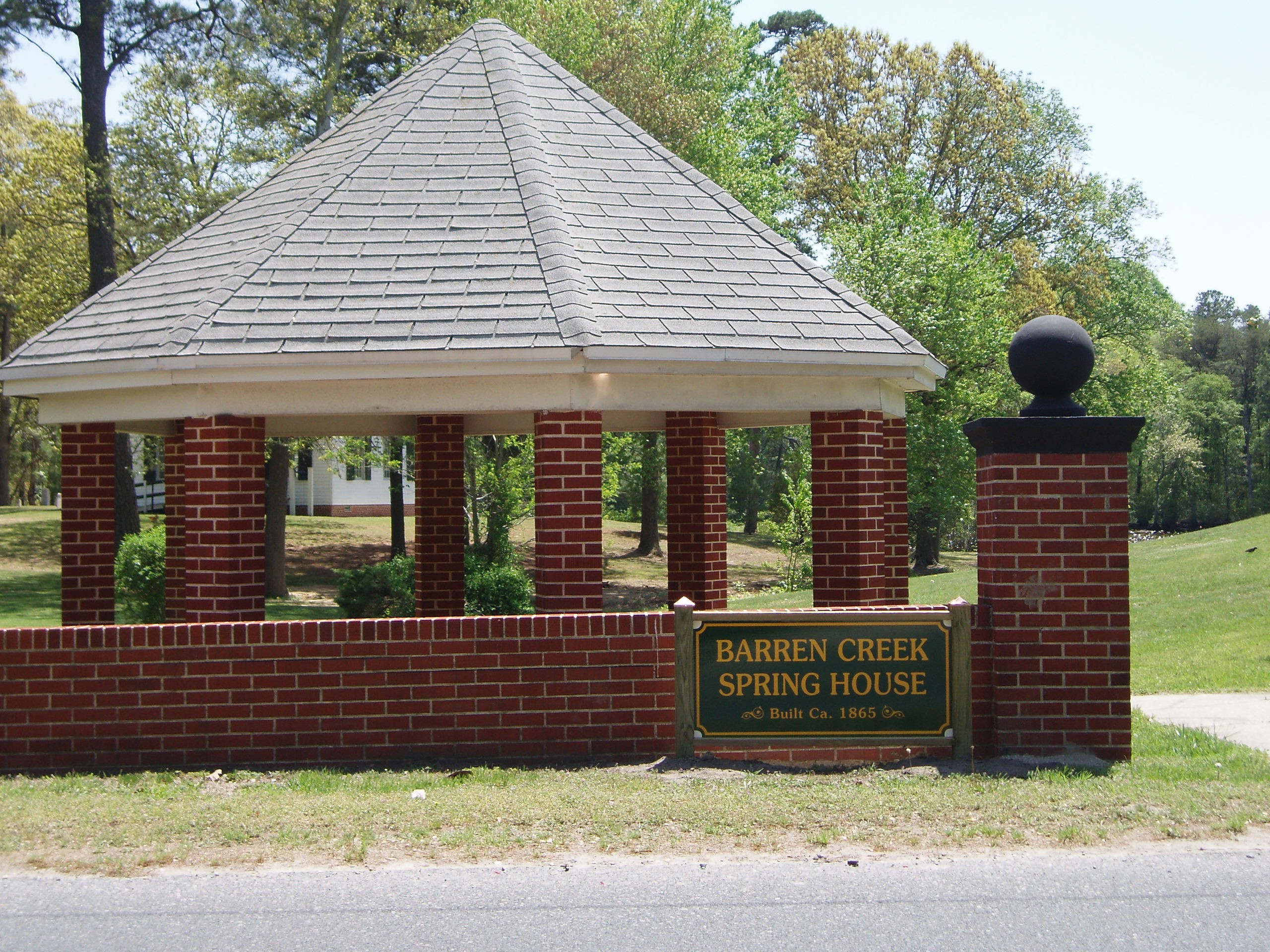 Barren Creek Spring House – The Spring House was a popular destination for tourists from the 1800s until the mid 1900s, as visitors flocked to the region to drink the town’s spring water and wade in it. The site is now managed by the Westside Historical Society.
Barren Creek Spring House – The Spring House was a popular destination for tourists from the 1800s until the mid 1900s, as visitors flocked to the region to drink the town’s spring water and wade in it. The site is now managed by the Westside Historical Society.- Double Mills Grist Mill – This historical site is now owned by Double Mills, Inc., a group of local residents intent on restoring this last surviving water-powered, turbine-driven mill. The first mill on the site, on the North bank of Barren Creek, was built in the 1700’s. Through various stages of restoration, improvement, and additions, it operated continuously until a major storm in 1979 tore out the dam and much of the raceway. Today, efforts are underway to restore it to an educational heritage site, recalling the importance of milling as the first industry in the area. The mill and general store, a part of the site from the late 1800’s, are open to visitors by contacting Double Mills, Inc.
- Eastern Shore Baseball Hall of Fame Museum – Located inside Arthur W. Perdue Stadium — the home of the Delmarva Shorebirds — the Hall of Fame Museum opened on May 24, 1997 and is dedicated to the history, preservation and recognition of amateur, semi-pro and professional baseball as it was played in years past on the Del-Mar-Va peninsula. The museum is open every Delmarva Shorebirds home game (doors open one hour prior to game time). During the off-season, the museum is open for tours by appointment only.
- Edward H. Nabb Research Center of Delmarva History & Culture – The Nabb Research Center collects and preserves archival material, artifacts, books – including family history, maps, and microfilm pertaining to the Delmarva
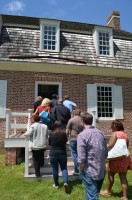 Peninsula. Delmarva includes Delaware and the eastern shores of Maryland and Virginia. It was a gateway from the Chesapeake Bay region in the earliest days to the bounty and promise of America.
Peninsula. Delmarva includes Delaware and the eastern shores of Maryland and Virginia. It was a gateway from the Chesapeake Bay region in the earliest days to the bounty and promise of America. - Pemberton Historical Park – This unique 262-acre historic park offers more than 5 miles of nature hiking trails. If you are visiting on a Sunday, be sure to tour Pemberton Hall, built in 1741, to view the exhibits and witness a historical interpretation. The Pemberton Hall Foundation also hosts special events at the Hall throughout the year, so be sure to visit their website for more information.
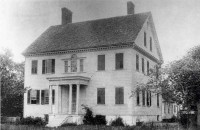 Poplar Hill Mansion – This beautiful Federal period manor house was built circa 1800 and is Salisbury’s oldest home. Now operated as a museum, the home was originally built by Major Levin Handy on a part of the tract called Pemberton’s Good Will. The two-story, five-bay frame house is a richly decorated dwelling, retaining a high percentage of its original woodwork. The interior spaces have recently been restored to its original color scheme and furnished true to its period.
Poplar Hill Mansion – This beautiful Federal period manor house was built circa 1800 and is Salisbury’s oldest home. Now operated as a museum, the home was originally built by Major Levin Handy on a part of the tract called Pemberton’s Good Will. The two-story, five-bay frame house is a richly decorated dwelling, retaining a high percentage of its original woodwork. The interior spaces have recently been restored to its original color scheme and furnished true to its period.- Whitehaven Ferry – Take a ride into history when you cross the Wicomico River on
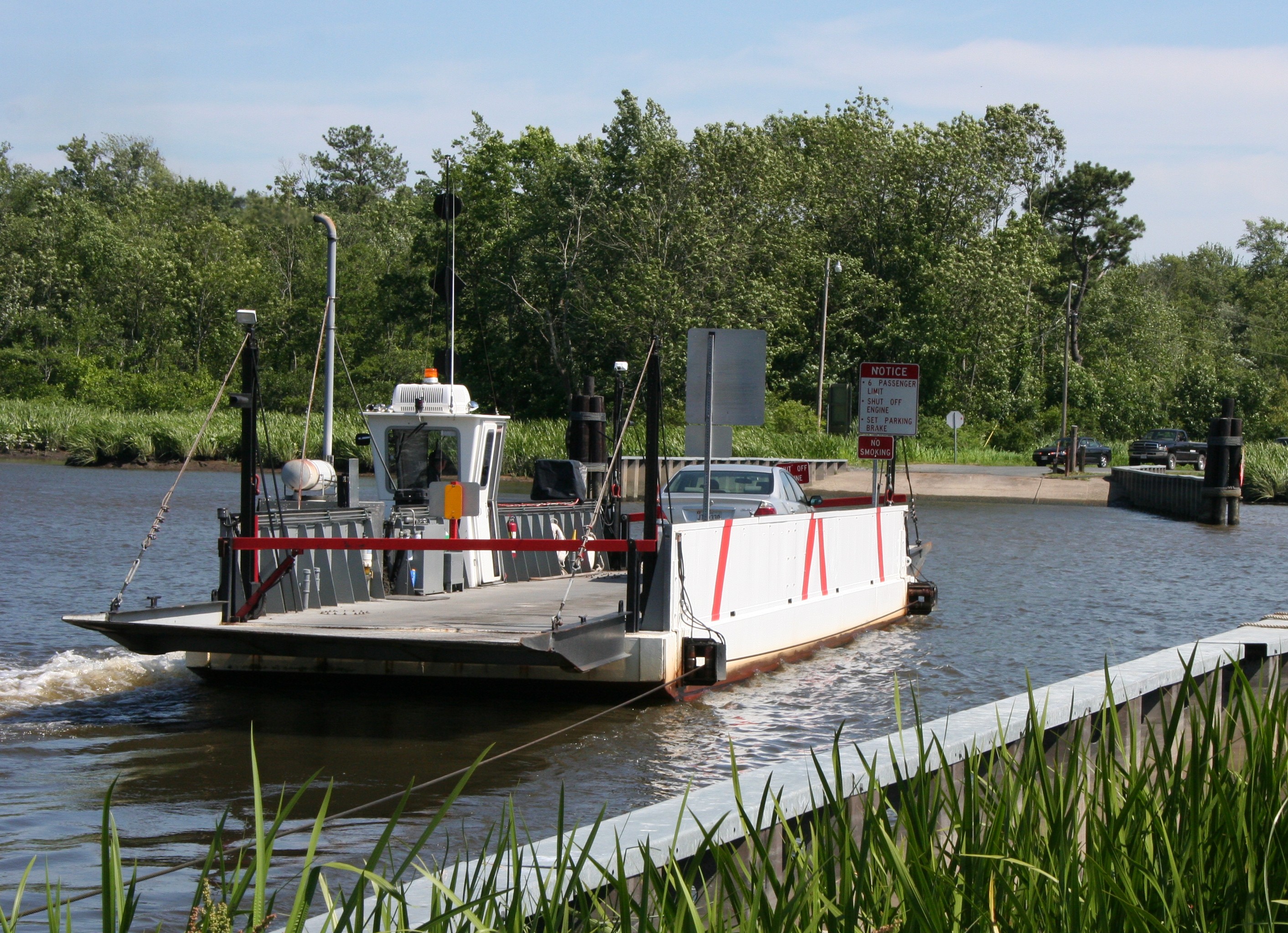 this three-car ferry. The first ferry here began operating in 1688 and the present ferry is thought to be the oldest continuously operating in the United States. The ferry brings travelers to or from Salisbury, MD from the quaint town of Whitehaven across the Wicomico River. Whitehaven remains little changed since colonial times. The hotel near the ferry, Whitehaven Hotel, began life as a private home in 1810 but became a hotel catering to travelers in 1877. Local legend says this is where Edna Ferber, inspired by the stories of the salesmen who traveled the Wicomico River wrote “Show Boat.”
this three-car ferry. The first ferry here began operating in 1688 and the present ferry is thought to be the oldest continuously operating in the United States. The ferry brings travelers to or from Salisbury, MD from the quaint town of Whitehaven across the Wicomico River. Whitehaven remains little changed since colonial times. The hotel near the ferry, Whitehaven Hotel, began life as a private home in 1810 but became a hotel catering to travelers in 1877. Local legend says this is where Edna Ferber, inspired by the stories of the salesmen who traveled the Wicomico River wrote “Show Boat.”
Delaware
Western Sussex County
- Bethel Maritime Museum – Bethel Maritime Museum is dedicated to the seafaring history of Bethel, Delaware. Operated by the Bethel Historical Society.
- Bridgeville Historical Society Complex – Sites include the Fire House Museum, Cahall Park, the Davis Building (a preserved tenant house), and museum of local artifacts and documents of a town whose motto is: “If you lived here, you would be home now.”
- The Cook House Museum – The Cook House contains the offices of the Laurel Historical Society, as well as a large number of photos and artifacts that help to tell the story of Laurel, Delaware and the residents who call it home.
- Delmar Railroad Museum – Delmar, known for its railroading history, is home to a unique highball signal listed on the National Register of Historic Places. Nearby, a 1929 caboose serves as museum for railroad artifacts. Call ahead for tours.
- The Laurel Heritage Museum – The Laurel Heritage Museum features an extensive collection of historical documents and objects displayed in the restored Laurel Train Station. The key element of the museum is the one-of-a-kind Waller Photographic Collection, which has been recognized as a premier historical collection by the Delaware Public Archives and the University of Delaware.
- Captain John Smith Memorial – A “new” chapter in Delaware history was written in 2007 when scientific studies of charts made by Captain John Smith revealed that he had reached Delaware while exploring the Chesapeake Bay and its tributaries. The wooded areas and walking trails of the surrounding Phillips Landing Recreation Area allow visitors to experience a taste of the isolated natural beauty that Smith encountered.
- Old Christ Church – Constructed in 1772, this historic place of worship is one of the few remaining unaltered wooden structures of its age and type in the United States. Located beside Chipman’s Pond approximately two miles east of Laurel, its paneled walls, barrel-vaulted ceiling, and wood box pews are evocative of pre-Revolutionary days when meeting places such as this were the community centers of rural colonial America.
- Ross Mansion & Plantation – The Governor Ross Plantation is the only site in Delaware that describes plantation life around the Civil War period. Learn about the life of a governor, slavery in Sussex County, and explore expansive grounds with auxiliary buildings that were necessary for the operation of a large plantation. Guided tours only, and by appointment.
- Seaford Museum – The Seaford Museum is a proud member of the Chesapeake Gateways and Watertrails Network in partnership with the National Park Service. Visiting the Seaford Museum will provide you with a delightful, unique experience journeying into the history and culture of the Nanticoke River headwaters. Featuring all fiber optic lighting and a maritime gallery, this museum tells the story of the local oyster shucking, shad fishing, steamboat, canning, and shipbuilding industries at the turn of the century.
Year-round antiquing itineraries can be found at the Visit Southern Delaware website.

